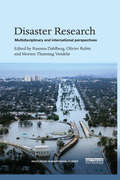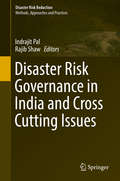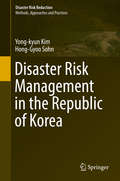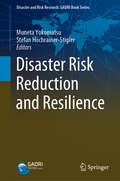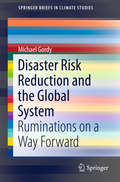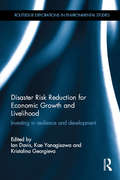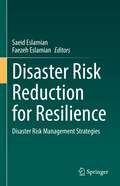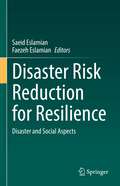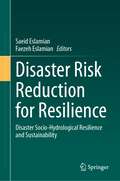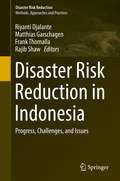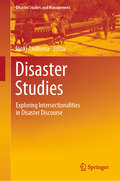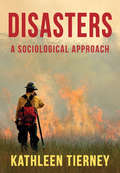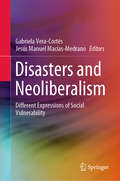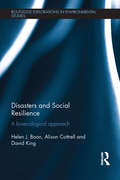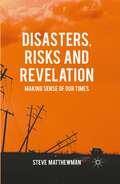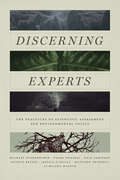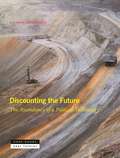- Table View
- List View
Disaster Research: Multidisciplinary and International Perspectives (Routledge Humanitarian Studies)
by Olivier Rubin Rasmus Dahlberg Morten Thanning VendeløGiven the tendency of books on disasters to predominantly focus on strong geophysical or descriptive perspectives and in-depth accounts of particular catastrophes, Disaster Research provides a much-needed multidisciplinary perspective of the area. This book is is structured thematically around key approaches to disaster research from a range of different, but often complementary academic disciplines. Each chapter presents distinct approaches to disaster research that is anchored in a particular discipline; ranging from the law of disasters and disaster historiography to disaster politics and anthropology of disaster. The methodological and theoretical contributions underlining a specific approach to disasters are discussed and illustrative empirical cases are examined that support and further inform the proposed approach to disaster research. The book thus provides unique insights into fourteen state-of-the-art disciplinary approaches to the understanding of disasters. The theoretical discussions as well as the diverse range of disaster cases should be of interest to both postgraduate and undergraduate students, as well as academics, researchers and policymakers.
Disaster Risk Governance in India and Cross Cutting Issues (Disaster Risk Reduction)
by Indrajit Pal Rajib ShawThis book provides an analytical discussion of the status of disaster risk reduction and governance in an Indian context, drawing examples and lessons from the output of the national and regional level programs and projects and from other relevant experiences in the country. Different types of disasters faced by Indian states are covered, including geophysical and hydrometeorological hazards. The book incorporates and draws upon some of the key lessons from the pre-disaster phase through the disaster phase and finally to the post-disaster phase, thus establishing an effective framework in the form of key lessons learned. The rich content of the book is based on contributions from various stakeholders, from academicians and practitioners to decision makers and nongovernment organizations related to disaster risk management systems in an Indian context. Special emphasis is given to analyzing field experiences from academic perspectives and pointing out key issues along with the relevance of risk governance of disaster risk reduction. The book works as a comprehensive reference in disaster risk governance for disaster managers in India and other countries. The book has 19 chapters organized into four parts. Part I provides the outline and basics of disaster risk governance perspectives at the national level with supporting examples from a global point of view. Part II specifically emphasizes the detailed perspectives on risk governance at the regional and local levels. Part III is devoted to approaches and issues of disaster risk governance and development at various levels, stressing the practices and clear examples of disaster risk governance, policy options, institutional organization, risk-reduction strategies, and key lessons learned. Finally, Part IV highlights risk reduction and cross-cutting issues, focusing on risk mitigation and scientific intervention for disaster risk reduction.
Disaster Risk Management in the Republic of Korea (Disaster Risk Reduction)
by Yong-Kyun Kim Hong-Gyoo SohnThis book scrutinizes the entire disaster trajectory history in the Republic of Korea: evolution, cross-over, and interconnection among natural, technological, and social disasters. Also examined is the government’s dynamic reaction for effective disaster responses in the wake of major disasters, labelled as focusing events, distributed in the long tail of the power law function. Collating one nation’s entire disaster history, its disaster management policies, and its responses to major disasters is a unique journey into that nation’s evolution. Korea rose from devastation in the 1950s to become one of the most economically and politically dynamic nations by the turn of the century. However, with rapid growth has come all types of disasters. Looking at the lessons learned from Korea’s disaster risk management measures, policies, and responses, as well as some of the world’s major disasters, we can gain insight into the future of disaster risk management.This book is intended to lay out developing nations’ potential future disaster risk management path, a theoretical policymaking guide, and desirable institutional and organizational transformations. Effective countermeasures included in this book will guide policymakers, capacity builders, and academics in developing nations to avoid the disaster path in the near future at the cost of rapid economic growth that Korea faced.
Disaster Risk Reduction and Resilience (Disaster and Risk Research: GADRI Book Series)
by Muneta Yokomatsu Stefan Hochrainer-StiglerThis book provides insight on how disaster risk management can increase the resilience of society to various natural hazards. The multi-dimensionality of resilience and the various different perspectives in regards to disaster risk reduction are taken explicitly into account by providing studies and approaches on different scales and ranging from natural science based methods to social science frameworks. For all chapters, special emphasis is placed on implementation aspects and specifically in regards to the targets and priorities for action laid out in the Sendai Framework for Disaster Risk Reduction. The chapters provide also a starting point for interested readers on specific issues of resilience and therefore include extensive reference material and important future directions for research.
Disaster Risk Reduction and the Global System: Ruminations on a Way Forward (SpringerBriefs in Climate Studies)
by Michael GordyThis short manuscript is both a distillation of some of the latest work on disaster risk reduction and an interpretation of this distillation from the author's political economic perspective. It is based on information found in the flagship reports on disaster risk reduction of the United Nations.The book sums up and interprets issues of disaster risk reduction and makes them accessible to professional and non-professional readers alike, including governmental policy makers.
Disaster Risk Reduction for Economic Growth and Livelihood: Investing in Resilience and Development (Routledge Explorations in Environmental Studies)
by Ian Davis Kae Yanagisawa Kristalina GeorgievaThe prevalence of natural disasters in recent years has highlighted the importance of preparing adequately for disasters and dealing efficiently with their consequences. This book addresses how countries can enhance their resilience against natural disasters and move towards economic growth and sustainable development. Covering a wide range of issues, it shows how well thought-out measures can be applied to minimize the impacts of disasters in a variety of situations. Starting with the need for coping with a rapidly changing global environment, the book goes on to demonstrate ways to strengthen awareness of the effectiveness of preventive measures, including in the reconstruction phase. The book also covers the roles played by different actors as well as tools and technologies for improved disaster risk reduction. It focuses on a variety of case studies from across Asia, Africa and Latin America, drawing out lessons that can be applied internationally. This book will be of great interest to professionals in disaster management, including national governments, donors, communities/citizens, NGOs and private sector. It will also be a highly valuable resource for students and researchers in disaster management and policy, development studies and economics.
Disaster Risk Reduction for Economic Growth and Livelihood: Investing in Resilience and Development (Routledge Explorations in Environmental Studies)
by Ian Davis Kae Yanagisawa Kristalina GeorgievaThe prevalence of natural disasters in recent years has highlighted the importance of preparing adequately for disasters and dealing efficiently with their consequences. This book addresses how countries can enhance their resilience against natural disasters and move towards economic growth and sustainable development. Covering a wide range of issues, it shows how well thought-out measures can be applied to minimize the impacts of disasters in a variety of situations. Starting with the need for coping with a rapidly changing global environment, the book goes on to demonstrate ways to strengthen awareness of the effectiveness of preventive measures, including in the reconstruction phase. The book also covers the roles played by different actors as well as tools and technologies for improved disaster risk reduction. It focuses on a variety of case studies from across Asia, Africa and Latin America, drawing out lessons that can be applied internationally. This book will be of great interest to professionals in disaster management, including national governments, donors, communities/citizens, NGOs and private sector. It will also be a highly valuable resource for students and researchers in disaster management and policy, development studies and economics.
Disaster Risk Reduction for Resilience: Disaster Risk Management Strategies
by Saeid Eslamian Faezeh EslamianThis book is part of a six-volume series on Disaster Risk Reduction and Resilience. The series aims to fill in gaps in theory and practice in the Sendai Framework, and provides additional resources, methodologies and communication strategies to enhance the plan for action and targets proposed by the Sendai Framework. The series will appeal to a broad range of researchers, academics, students, policy makers and practitioners in engineering, environmental science and geography, geoscience, emergency management, finance, community adaptation, atmospheric science and information technology. This volume offers the international guidelines and global standards for resilient disaster risk reduction and lessons learned from disasters, particularly the COVID-19 and Cholera pandemics. A resilient health system and an effective disaster risk management Index are then suggested. The book further emphasizes urban resilience strategies with local authorities, adaptation strategies for urban heat at regional, city and local scales, and lessons from community-level interventions. Also addressed are coastal erosion, displacement and resettlement strategies. Land use planning and green infrastructure are suggested as tools for natural hazards reduction. Human security in times of climate change and urban heat at regional, city and local scales is discussed for an integrated action, with case studies based in Manila, Burkina Faso, Chad, Mauritania, Niger, Senegal, Nigeria, India, Spain, and Ghana. Structure design for cascading disasters resulting from mining and flooding is presented and sustainable smart city planning using spatial data is recommended.
Disaster Risk Reduction for Resilience: Disaster and Social Aspects
by Saeid Eslamian Faezeh EslamianThis book is part of a six-volume series on Disaster Risk Reduction and Resilience. The series aims to fill in gaps in theory and practice in the Sendai Framework and provides additional resources, methodologies, and communication strategies to enhance the plan for action and targets proposed by the Sendai Framework. The series will appeal to a broad range of researchers, academics, students, policy makers, and practitioners in engineering, environmental science, geography, geoscience, emergency management, finance, community adaptation, atmospheric science and information technology.This volume provides a holistic approach to developing disaster risk reduction strategies and policies, exploring the most effective ways to integrate physical and social science aspects of hazard resilience to better inform local populations. This risk-based approach to community resilience development is used to craft a collaborative system for crisis management, and allows for the implementation of nationally determined contributions (NDCs) through social innovation and community engagement to enhance community emergency response support and preparedness. Readers will also learn about education of disaster risk reduction, human health risk assessment, gendered perspectives in disaster response, recovery, and disaster management legislation.
Disaster Risk Reduction for Resilience: Disaster Socio-Hydrological Resilience and Sustainability
by Saeid Eslamian Faezeh EslamianThis book is part of a six-volume series on Disaster Risk Reduction and Resilience. The series aims to fill in gaps in theory and practice in the Sendai Framework, and provides additional resources, methodologies and communication strategies to enhance the plan for action and targets proposed by the Sendai Framework. The series will appeal to a broad range of researchers, academics, students, policy makers and practitioners in engineering, environmental science and geography, geoscience, emergency management, finance, community adaptation, atmospheric science and information technology.This volume discusses the implementation of socio-hydrological resilience measures to curb the impacts on vulnerable communities of hydrologic diasters such as coastal floods, drought, water scarcity, and thunderstorms. The book provides a framework for sustainable hydrology-community interactions to inform local communities about the best practices to achieve hydrological resilience, and to implement resilient water infrastructure. Hydrological influences on the resilience of a region are comprehensively surveyed, and a "green economy strategy" is described and recommended for achieving climatic and hydrological sustainability.
Disaster Risk Reduction in Indonesia: Progress, Challenges, and Issues (Disaster Risk Reduction)
by Riyanti Djalante Matthias Garschagen Frank Thomalla Rajib ShawThis book is a unique, transdisciplinary summary of the state of the art of disaster risk reduction (DRR) in Indonesia. It provides a comprehensive overview of disaster risk governance across all levels and multiple actors including diverse perspectives from practitioners and researchers on the challenges and progress of DRR in Indonesia. The book includes novel and emerging topics such as the role of culture, religion, psychology and the media in DRR. It is essential reading for students, researchers, and policy makers seeking to understand the nature and variety of environmental hazards and risk patterns affecting Indonesia.Following the introduction, the book has four main parts of key discussions. Part I presents disaster risk governance from national to local level and its integration into development sectors, Part II focuses on the roles of different actors for DRR, Part III discusses emerging issues in DRR research and practice, and Part IV puts forward variety of methods and studies to measure hazards, risks and community resilience.
Disaster Studies: Exploring Intersectionalities in Disaster Discourse (Disaster Studies and Management)
by Janki AndhariaThis book covers several dimensions of disaster studies as an emerging discipline. It is the inaugural book in the series ‘Disaster Studies and Management’ and deals with questions such as “Is disaster management a field of practice, a profession, or simply a new area of study?” Exploring intersectionalities, the book also examines areas of research that could help enhance the discourse on disaster management from policy and practice perspectives, revisiting conventional event-centric approaches, which are the basis for most writings on the subject. Several case studies and comparative analyses reflect a critical reading of research and practice concerning disasters and their management. The book offers valuable insights into various subjects including the challenge of establishing inter- and multi-disciplinary teams within the academia involved in disaster studies, and sociological and anthropological readings of post-disaster memoryscapes. Each of the contributors has an enduring interest in disaster studies, thus enriching the book immensely. This book will be of interest to all the students and scholars of disaster studies and disaster management, as well as to practitioners and policymakers.
Disasters: A Sociological Approach
by Kathleen TierneyDisasters kill, maim, and generate increasingly large economic losses. But they do not wreak their damage equally across populations, and every disaster has social dimensions at its very core. This important book sheds light on the social conditions and on the global, national, and local processes that produce disasters. Topics covered include the social roots of disaster vulnerability, exposure to natural hazards such as hurricanes and tsunamis as a form of environmental injustice, and emerging threats. Written by a leading expert in the field, this book provides the necessary frameworks for understanding hazards and disasters, exploring the contributions of very different social science fields to disaster research and showing how these ideas have evolved over time. Bringing the social aspects of recent devastating disasters to the forefront, Tierney discusses the challenges of conducting research in the aftermath of disasters and critiques the concept of disaster resilience, which has come to be seen as a key to disaster risk reduction. Peppered with case studies, research examples, and insights from very different disciplines, this rich introduction is an invaluable resource to students and scholars interested in the social nature of disasters and their relation to broader social forces.
Disasters and Neoliberalism: Different Expressions of Social Vulnerability
by Gabriela Vera-Cortés Jesús Manuel Macías-MedranoThis book shows how the adoption of the neoliberal development model has increased the social vulnerability to disasters, with a special focus on Mexico, a country which once was the role model of the neoliberal turn in Latin America. It brings together 12 case studies of disasters such as floods, earthquakes and volcanic emergencies, in both urban and rural areas, to show how neoliberal development projects and changes in legislation affected disaster prevention and management in different parts of the country. The case studies from Mexico are complemented by two comparative studies which analyze the impacts of neoliberalism in disaster prevention and management in Mexico, Brazil, United States and Italy. Disasters and Neoliberalism: Different Expressions of Social Vulnerability presents a unique contribution to the interdisciplinary field of disaster research by presenting qualitative studies of disaster vulnerability from the perspective of scholars from the Global South, bringing a fresh and critical approach to English speaking social sciences qualitative researchers working on disaster risks in a number of fields, such as geography, anthropology, sociology, political science and environmental studies.
Disasters and Social Resilience: A bioecological approach (Routledge Explorations in Environmental Studies)
by David King Helen J. Boon Alison CottrellThe interconnectedness of communities, organisations, governing bodies, policy and individuals in the field of disaster studies has never been accurately examined or comprehensively modelled. This kind of study is vital for planning policy and emergency responses and assessing individual and community vulnerability, resilience and sustainability as well as mitigation and adaptation to climate change impacts; it therefore deserves attention. Disasters and Social Resilience fills this gap by introducing to the field of disaster studies a fresh methodology and a model for examining and measuring impacts and responses to disasters. Urie Bronfenbrenner’s bioecological systems theory, which is used to look at communities holistically, is outlined and illustrated through a series of chapters, guiding the reader from the theory's underpinnings through research illustrations and applications focused on each level of Bronfenbrenner’s ecosystems, culminating in an integration chapter. The final chapter provides policy recommendations for local and national government bodies and emergency providers to help individuals and communities prepare and withstand the effects of a range of disasters. This book will be of great interest to scholars and students of disaster and emergency management, disaster readiness and risk reduction (DRR), and to scholars and students of more general climate change and sustainability studies.
Disasters and Social Resilience: A bioecological approach (Routledge Explorations in Environmental Studies)
by David King Helen J. Boon Alison CottrellThe interconnectedness of communities, organisations, governing bodies, policy and individuals in the field of disaster studies has never been accurately examined or comprehensively modelled. This kind of study is vital for planning policy and emergency responses and assessing individual and community vulnerability, resilience and sustainability as well as mitigation and adaptation to climate change impacts; it therefore deserves attention. Disasters and Social Resilience fills this gap by introducing to the field of disaster studies a fresh methodology and a model for examining and measuring impacts and responses to disasters. Urie Bronfenbrenner’s bioecological systems theory, which is used to look at communities holistically, is outlined and illustrated through a series of chapters, guiding the reader from the theory's underpinnings through research illustrations and applications focused on each level of Bronfenbrenner’s ecosystems, culminating in an integration chapter. The final chapter provides policy recommendations for local and national government bodies and emergency providers to help individuals and communities prepare and withstand the effects of a range of disasters. This book will be of great interest to scholars and students of disaster and emergency management, disaster readiness and risk reduction (DRR), and to scholars and students of more general climate change and sustainability studies.
Disasters, Risks and Revelation: Making Sense of Our Times
by Steve MatthewmanDisasters are part of the modern condition, a source of physical anxiety and existential angst, and they are increasing in frequency, cost and severity. Drawing on both disaster research and social theory, this book offers a critical examination of their causes, consequences and future avoidance.
Discerning Experts: The Practices of Scientific Assessment for Environmental Policy
by Michael Oppenheimer Naomi Oreskes Dale Jamieson Keynyn Brysse Jessica O’Reilly Matthew Shindell Milena WazeckDiscerning Experts assesses the assessments that many governments rely on to help guide environmental policy and action. Through their close look at environmental assessments involving acid rain, ozone depletion, and sea level rise, the authors explore how experts deliberate and decide on the scientific facts about problems like climate change. They also seek to understand how the scientists involved make the judgments they do, how the organization and management of assessment activities affects those judgments, and how expertise is identified and constructed. Discerning Experts uncovers factors that can generate systematic bias and error, and recommends how the process can be improved. As the first study of the internal workings of large environmental assessments, this book reveals their strengths and weaknesses, and explains what assessments can—and cannot—be expected to contribute to public policy and the common good.
Discerning Experts: The Practices of Scientific Assessment for Environmental Policy
by Michael Oppenheimer Naomi Oreskes Dale Jamieson Keynyn Brysse Jessica O’Reilly Matthew Shindell Milena WazeckDiscerning Experts assesses the assessments that many governments rely on to help guide environmental policy and action. Through their close look at environmental assessments involving acid rain, ozone depletion, and sea level rise, the authors explore how experts deliberate and decide on the scientific facts about problems like climate change. They also seek to understand how the scientists involved make the judgments they do, how the organization and management of assessment activities affects those judgments, and how expertise is identified and constructed. Discerning Experts uncovers factors that can generate systematic bias and error, and recommends how the process can be improved. As the first study of the internal workings of large environmental assessments, this book reveals their strengths and weaknesses, and explains what assessments can—and cannot—be expected to contribute to public policy and the common good.
Discerning Experts: The Practices of Scientific Assessment for Environmental Policy
by Michael Oppenheimer Naomi Oreskes Dale Jamieson Keynyn Brysse Jessica O’Reilly Matthew Shindell Milena WazeckDiscerning Experts assesses the assessments that many governments rely on to help guide environmental policy and action. Through their close look at environmental assessments involving acid rain, ozone depletion, and sea level rise, the authors explore how experts deliberate and decide on the scientific facts about problems like climate change. They also seek to understand how the scientists involved make the judgments they do, how the organization and management of assessment activities affects those judgments, and how expertise is identified and constructed. Discerning Experts uncovers factors that can generate systematic bias and error, and recommends how the process can be improved. As the first study of the internal workings of large environmental assessments, this book reveals their strengths and weaknesses, and explains what assessments can—and cannot—be expected to contribute to public policy and the common good.
Discerning Experts: The Practices of Scientific Assessment for Environmental Policy
by Michael Oppenheimer Naomi Oreskes Dale Jamieson Keynyn Brysse Jessica O’Reilly Matthew Shindell Milena WazeckDiscerning Experts assesses the assessments that many governments rely on to help guide environmental policy and action. Through their close look at environmental assessments involving acid rain, ozone depletion, and sea level rise, the authors explore how experts deliberate and decide on the scientific facts about problems like climate change. They also seek to understand how the scientists involved make the judgments they do, how the organization and management of assessment activities affects those judgments, and how expertise is identified and constructed. Discerning Experts uncovers factors that can generate systematic bias and error, and recommends how the process can be improved. As the first study of the internal workings of large environmental assessments, this book reveals their strengths and weaknesses, and explains what assessments can—and cannot—be expected to contribute to public policy and the common good.
Discerning Experts: The Practices of Scientific Assessment for Environmental Policy
by Michael Oppenheimer Naomi Oreskes Dale Jamieson Keynyn Brysse Jessica O’Reilly Matthew Shindell Milena WazeckDiscerning Experts assesses the assessments that many governments rely on to help guide environmental policy and action. Through their close look at environmental assessments involving acid rain, ozone depletion, and sea level rise, the authors explore how experts deliberate and decide on the scientific facts about problems like climate change. They also seek to understand how the scientists involved make the judgments they do, how the organization and management of assessment activities affects those judgments, and how expertise is identified and constructed. Discerning Experts uncovers factors that can generate systematic bias and error, and recommends how the process can be improved. As the first study of the internal workings of large environmental assessments, this book reveals their strengths and weaknesses, and explains what assessments can—and cannot—be expected to contribute to public policy and the common good.
Discerning Experts: The Practices of Scientific Assessment for Environmental Policy
by Michael Oppenheimer Naomi Oreskes Dale Jamieson Keynyn Brysse Jessica O’Reilly Matthew Shindell Milena WazeckDiscerning Experts assesses the assessments that many governments rely on to help guide environmental policy and action. Through their close look at environmental assessments involving acid rain, ozone depletion, and sea level rise, the authors explore how experts deliberate and decide on the scientific facts about problems like climate change. They also seek to understand how the scientists involved make the judgments they do, how the organization and management of assessment activities affects those judgments, and how expertise is identified and constructed. Discerning Experts uncovers factors that can generate systematic bias and error, and recommends how the process can be improved. As the first study of the internal workings of large environmental assessments, this book reveals their strengths and weaknesses, and explains what assessments can—and cannot—be expected to contribute to public policy and the common good.
Discounting the Future: The Ascendancy of a Political Technology
by Liliana DoganovaA pioneering exploration of the defining traits and contradictions of our relationship to the future through the lens of discountingForest fires, droughts, and rising sea levels beg a nagging question: have we lost our capacity to act on the future? Liliana Doganova&’s book sheds new light on this anxious query. It argues that our relationship to the future has been trapped in the gears of a device called discounting. While its incidence remains little known, discounting has long been entrenched in market and policy practices, shaping the ways firms and governments look to the future and make decisions accordingly. Thus, a sociological account of discounting formulas has become urgent.Discounting means valuing things through the flows of costs and benefits that they are likely to generate in the future, with these future flows being literally dis-counted as they are translated in the present. How have we come to think of the future, and of valuation, in such terms? Building on original empirical research in the historical sociology of discounting, Doganova takes us to some of the sites and moments in which discounting took shape and gained momentum: valuation of European forests in the eighteenth and nineteenth centuries; economic theories devised in the early 1900s; debates over business strategies in the postwar era; investor-state disputes over the nationalization of natural resources; and drug development in the biopharmaceutical industry today. Weaving these threads together, the book pleads for an understanding of discounting as a political technology, and of the future as a contested domain.
Discounting the Future: The Ascendancy of a Political Technology
by Liliana DoganovaA pioneering exploration of the defining traits and contradictions of our relationship to the future through the lens of discountingForest fires, droughts, and rising sea levels beg a nagging question: have we lost our capacity to act on the future? Liliana Doganova&’s book sheds new light on this anxious query. It argues that our relationship to the future has been trapped in the gears of a device called discounting. While its incidence remains little known, discounting has long been entrenched in market and policy practices, shaping the ways firms and governments look to the future and make decisions accordingly. Thus, a sociological account of discounting formulas has become urgent.Discounting means valuing things through the flows of costs and benefits that they are likely to generate in the future, with these future flows being literally dis-counted as they are translated in the present. How have we come to think of the future, and of valuation, in such terms? Building on original empirical research in the historical sociology of discounting, Doganova takes us to some of the sites and moments in which discounting took shape and gained momentum: valuation of European forests in the eighteenth and nineteenth centuries; economic theories devised in the early 1900s; debates over business strategies in the postwar era; investor-state disputes over the nationalization of natural resources; and drug development in the biopharmaceutical industry today. Weaving these threads together, the book pleads for an understanding of discounting as a political technology, and of the future as a contested domain.
